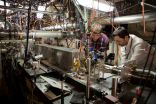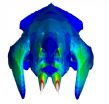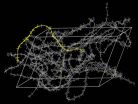(Press-News.org) The first fossil of an amphibious ichthyosaur has been discovered in China by a team led by researchers at the University of California, Davis. The discovery is the first to link the dolphin-like ichthyosaur to its terrestrial ancestors, filling a gap in the fossil record. The fossil is described in a paper published in advance online Nov. 5 in the journal Nature.
The fossil represents a missing stage in the evolution of ichthyosaurs, marine reptiles from the Age of Dinosaurs about 250 million years ago. Until now, there were no fossils marking their transition from land to sea.
"But now we have this fossil showing the transition," said lead author Ryosuke Motani, a professor in the UC Davis Department of Earth and Planetary Sciences. "There's nothing that prevents it from coming onto land."
Motani and his colleagues discovered the fossil in China's Anhui Province. About 248 million years old, it is from the Triassic period and measures roughly 1.5 feet long.
Unlike ichthyosaurs fully adapted to life at sea, this one had unusually large, flexible flippers that likely allowed for seal-like movement on land. It had flexible wrists, which are essential for crawling on the ground. Most ichthyosaurs have long, beak-like snouts, but the amphibious fossil shows a nose as short as that of land reptiles.
Its body also contains thicker bones than previously-described ichthyosaurs. This is in keeping with the idea that most marine reptiles who transitioned from land first became heavier, for example with thicker bones, in order to swim through rough coastal waves before entering the deep sea.
The study's implications go beyond evolutionary theory, Motani said. This animal lived about 4 million years after the worst mass extinction in Earth's history, 252 million years ago. Scientists have wondered how long it took for animals and plants to recover after such destruction, particularly since the extinction was associated with global warming.
"This was analogous to what might happen if the world gets warmer and warmer," Motani said. "How long did it take before the globe was good enough for predators like this to reappear? In that world, many things became extinct, but it started something new. These reptiles came out during this recovery."
INFORMATION:
In addition to UC Davis, the research team included scientists from Peking University, Anhui Geological Museum, Chinese Academy of Science, University of Milan, and The Field Museum in Chicago.
The study received funding from the National Geographic Society, National Natural Science Foundation of China, Nanjing Institute of Geology and Palaeontology, Research Fund for the Doctoral Program of Higher Education, and the Department of Land and Resource of Anhui Province.
First amphibious ichthyosaur discovered, filling evolutionary gap
2014-11-05
ELSE PRESS RELEASES FROM THIS DATE:
Coexist or perish, new wildfire analysis says
2014-11-05
Many fire scientists have tried to get Smokey the Bear to hang up his "prevention" motto in favor of tools like thinning and prescribed burns, which can manage the severity of wildfires while allowing them to play their natural role in certain ecosystems.
But a new international research review led by the University of California, Berkeley, says the debate over fuel-reduction techniques is only a small part of a much larger fire problem that will make society increasingly vulnerable to catastrophic losses unless it changes its fundamental approach from fighting fire ...
Osteoporosis, not just a woman's disease
2014-11-05
BOSTON – Each year nearly two million Americans suffer osteoporosis-related fractures, and as the population ages that number is expected to increase dramatically, placing a major burden on the health care system. While osteoporosis prevention and treatment efforts have historically been focused on post-menopausal women, a new study from Beth Israel Deaconess Medical Center (BIDMC) suggests that critical opportunities are being lost by not focusing more attention on bone loss and fracture risk in older men.
"Given that the prevalence of fragility fractures among ...
Genesis of genitalia
2014-11-05
When it comes to genitalia, nature enjoys variety. Snakes and lizards have two. Birds and people have one. And while the former group's paired structures are located somewhat at the level of the limbs, ours, and the birds', appear a bit further down. In fact, snake and lizard genitalia are derived from tissue that gives rise to hind legs, while mammalian genitalia are derived from the tail bud. But despite such noteworthy contrasts, these structures are functionally analogous and express similar genes.
How do these equivalent structures arise from different starting ...
Researchers hit milestone in accelerating particles with plasma
2014-11-05
Scientists from the Department of Energy's SLAC National Accelerator Laboratory and the University of California, Los Angeles have shown that a promising technique for accelerating electrons on waves of plasma is efficient enough to power a new generation of shorter, more economical accelerators. This could greatly expand their use in areas such as medicine, national security, industry and high-energy physics research.
This achievement is a milestone in demonstrating the practicality of plasma wakefield acceleration, a technique in which electrons gain energy by essentially ...
Madagascar: Fossil skull analysis offers clue to mammals' evolution
2014-11-05
AMHERST, Mass. – The surprise discovery of the fossilized skull of a 66- to 70-million-year-old, groundhog-like creature on Madagascar has led to new analyses of the lifestyle of the largest known mammal of its time by a team of specialists including biologist Elizabeth Dumont at the University of Massachusetts Amherst, an expert in jaw structure and bite mechanics.
The skull of this animal, named Vintana sertichi, was found in a geological formation deposited when a great variety of dinosaurs roamed the earth. With a skull that is almost five inches (125 mm) ...
New global wildfire analysis indicates humans need to coexist and adapt
2014-11-05
A new study led by the University of California, Berkeley and involving the University of Colorado Boulder indicates the current response to wildfires around the world—aggressively fighting them—is not making society less vulnerable to such events.
The study suggests the key is to treat fires like other natural hazards—including earthquakes, severe storms and flooding—by learning to coexist, adapt and identify vulnerabilities. The new study indicates government-sponsored firefighting and land management policies may actually encourage development ...
Bone drug should be seen in a new light for its anti-cancer properties
2014-11-05
Australian researchers have shown why calcium-binding drugs commonly used to treat people with osteoporosis, or with late-stage cancers that have spread to bone, may also benefit patients with tumours outside the skeleton, including breast cancer.
Several clinical trials – where women with breast cancer were given these drugs (bisphosphonates) alongside normal treatment for early-stage disease – showed that they can confer a 'survival advantage' and inhibit cancer spread in some women, although until now no-one has understood why.
A new study by Professor ...
Clearing a path for electrons in polymers: Closing in on the speed limits
2014-11-05
Researchers from the University of Cambridge have identified a class of low-cost, easily-processed semiconducting polymers which, despite their seemingly disorganised internal structure, can transport electrons as efficiently as expensive crystalline inorganic semiconductors.
In this new polymer, about 70% of the electrons are free to travel, whereas in conventional polymers that number can be less than 50%. The materials approach intrinsic disorder-free limits, which would enable faster, more efficient flexible electronics and displays. The results are published today ...
Sustainable co-existence with wildfire recognizes ecological benefits, human needs
2014-11-05
CHICAGO (November 5, 2014) – When wildfire and people intersect, it is often in the wildland-urban interface, or WUI, a geography where homes, roads and trails intermix with fire-prone vegetation. In an article published Thursday in the journal Nature, U.S. Forest Service scientist Sarah McCaffrey and her colleagues advocate for an approach to wildfire management that reflects ecological science as well as research on the human dimensions of wildfire and fire management.
"Learning to Coexist with Wildfire," a research review led by the University of California-Berkley, ...
Readmission rates above average for survivors of septic shock, Penn study finds
2014-11-05
PHILADELPHIA –A diagnosis of septic shock was once a near death sentence. At best, survivors suffered a substantially reduced quality of life.
Penn Medicine researchers have now shown that while most patients now survive a hospital stay for septic shock, 23 percent will return to the hospital within 30 days, many with another life-threatening condition -- a rate substantially higher than the normal readmission rate at a large academic medical center. The findings are published in the new issue of Critical Care Medicine.
"Half of patients diagnosed with sepsis ...






